0 Update added 30th Nov
- by David Lawson
- 30-11-2017
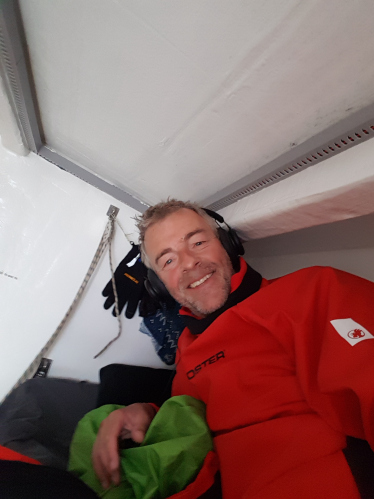
So today I thought I’d try to give you an idea of what life on a racing yacht is really like. Now a racing yacht has absolutely nothing to do with cruising so life below is pretty basic and when the boast has its sails up and we’re heeled over to port or starboard side then living below really does become an Olympic sport. Add to that the up and down motion, if we are beating into the wind, and it becomes more about surviving below rather than living below.
There is a small galley on the boat with an oven, stove, 2 small sinks and some storage areas. The storage areas are normally for bowls (we don’t use plates) utensils, condiments, and the things you need on a daily basis. Food is broken down into day bags for each day of the race leg and these are stored either under the bunks or under the floor boards in the bilge areas of the boat. We do take some fresh fruit and veg with us which is stored in nets under a couple of bunks and we have eggs as well. Other things we will use every day such as cereal is stored in bulk in bags. As the boat gets very wet all the bags are dry bags to help keep the contents dry before they are used.
Cooking is usually on a one pot basis with curries and rice or pasta being the staples of choice. We have a small freezer box and cool box so can take some frozen meat with us to add protein to our diet. Lots of tins were used on the last leg with soup, beans, chickpeas, mixed veg, tomatoes, fruit etc.
As we eat out of bowls and to save washing up we use the same bowl for pudding and now I’ve become very partial to tinned fruit and curry/chilli flavoured custard! Yum!!
Cooking has become a creative process, Masterchef meets the ocean, and as crew we all have to get involved on an allocated basis for Mother Watch save the Skipper and his Coxwains, Watch Leaders. So if you’ve not cooked before, well that’s just too bad, and to be fair on the whole the food was pretty good. The advantage of being on Mother Watch is you get a full night in your bunk as you’re excused watch duty for the 24 hrs. So on this leg I had 3 Mother Watch duties which gave me 3 nights to catch up on sleep. Bit difficult with all the noise, the rolling of the boat and the watch changes as they happen.
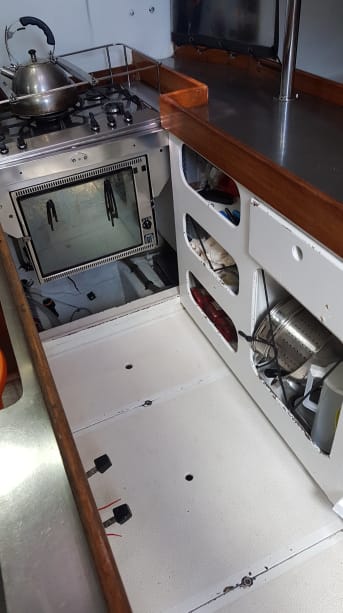
Galley looking good after a 3 hr clean after we arrived in Fremantle
The biggest danger to those on Mother Watch is when a tack or gybe takes place and the boat moves with the high side of the boat going from one side to the other. Bowls go everywhere, including the contents (I lost my pudding several times!), and so a thoughtful notification from those on the deck is always helpful.
As there are more crew than bunks we have a ‘hot bunking’ scheme and bunks are normally doubled up. So on watch changeover it’s one out and then one in. Each bunk has 3 small cubby areas for our kit and sleeping bags. Because of limited space we have an allowance of 20kgs plus foulies, boots and sleeping bag. So it’s pretty much just the basics and then rush to wash everything when you’re back onshore.
I was lucky to have my own bunk for the last leg as we had a round the world crew member leave the boat in Cape Town. The bunks are restricted on height and as the boat leans you have to learn pretty quickly to pull your bunk up on the pulley system or risk falling out!
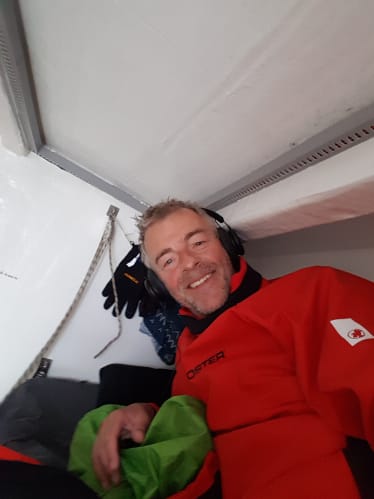
My bunk with the ultimate luxury (a clothes line!)
Now when my bunk is on the low side of the boat (the side of the boat in the water) then getting in and out is easy and there is plenty of headroom for sleeping. However, when I’m on the high side (the side of the boat out of the water) it’s more of a challenge because I’ve got to firstly raise my bunk on the pulley system to make it horizontal to sleep on. Raising it by 12 – 18 inches means I’ve got a further 12 – 18 inches to get up to get in. Fortunately, the engine room door was opposite me and so the process was to stand on the tank below the bunk below me, put my left foot on the door handle to the engine room, reach over my bunk to the housing for the cubby hole, swing my right leg up and pull myself into my bunk….easy! When you’re cold and really tired this really does become a psych yourself up first action.
Getting out was more of a challenge as I now had a 7 foot drop to the floor below so it was brace my left leg on the roof above me, reach over to the top of the engine room door with my left hand and then swing myself down to the floor below.
As the weather became colder less and less layers were removed before getting into my sleeping bag. For the colder nights I’d often have on 2 base layers, my fleece trousers and 3 shirts. I often took my socks off though and if anything was damp then it was stuffed into my sleeping bag with me so my body heat would dry it out.
I do have a wonderful ocean sleeping bag with a double fleece layer inside and it has been worth every penny.
Washing is solely a wet wipe process and shaving was avoided by most of us save a couple of brave souls who did shave regularly. I had a wet wipe, wipe over twice a day and a wet wipe bath twice a week and pants were changed weekly. We didn’t have the weight allowance to make this more often. Using merino wool base layers and socks means that you don’t get too smelly (well we all smelt the same by the end so what did it matter???).
We have two toilets (heads) on the boat. Using these becomes an exercise in wedging. I’ll save the details but using the heads became an exercise in planning in good time and then when you’re in there wedging yourself in place to save mishaps (enough said!!!).
With the boat heeled over moving around and getting dressed and undressed becomes a huge challenge. With wet floors from wet clothes it also becomes very slippery. I did move extremely quickly from one side of the boat one day and in a backwards direction to end up in the wet clothes locker on the other side. Fortunately no damage was done.
On another occasion I was dragging a spinnaker sail around to start ‘wooling’ it and as I passed the rear head the boat lurched sideways on a wave and I was dumped unceremoniously into the toilet area. Again I went in backwards and fortunately once again no damage was done. It’s really easy to hurt yourself and on one boat a lady had fallen on a winch on deck and fractured one arm and then later on in the race she had fallen out of her bunk and fractured her other shoulder. Both arms are now in slings and she’ll now be missing the next leg of the race.
I found the watch system really difficult to get into and sleep deprivation becomes a real issue. I’d find myself nodding off when on deck even in very cold conditions. Helming was one activity to stem this as the need to concentrate and physical effort involved meant you were always alert. Helming was limited to 30 minute sessions so that those on the helm could maintain their concentration and then take a rest.
Changing sails regularly is also very physical and after the first week I was both mentally and physically exhausted. The challenging weather of the first week didn’t help either.
Fortunately I wasn’t seasick despite the conditions. Many were and this is very debilitating and means those who are affected aren’t also able to get on deck which makes the workload greater for those on deck.
Fortunately I did have one real luxury with me, my music. On my off watch time during the day I’d lie in my bunk with headphones and music on and zone myself out of everything around me and just find some time for myself. Heaven. I’d even have my headphones and music on when I was making bread, baking cake or making biscuits. I’m not sure any of these turned out any better as a result but I enjoyed the process.
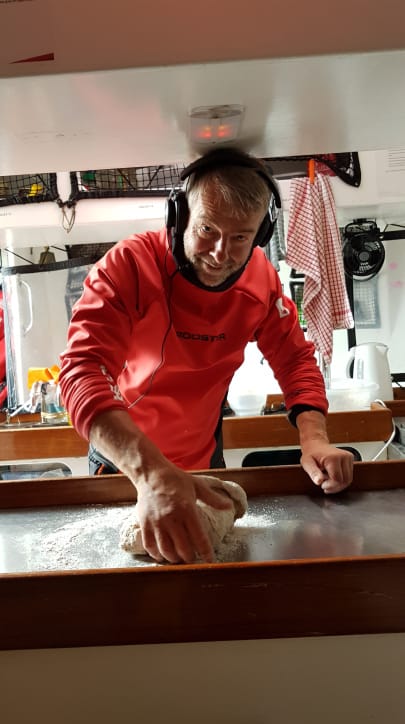
Kneading a bread mix in preparation for lunch
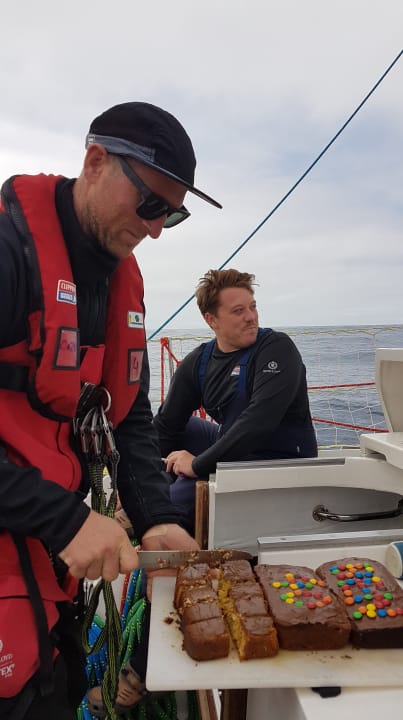
A cake I baked for Ben’s 40th birthday. Sponge with cranberries, Nutella and M&M’s. Yum!

